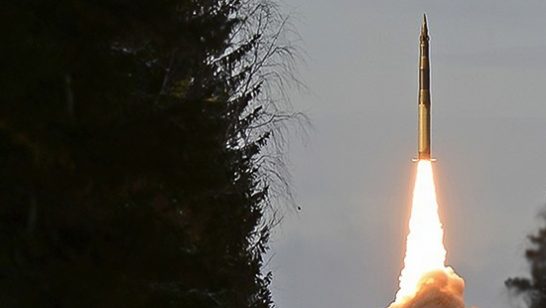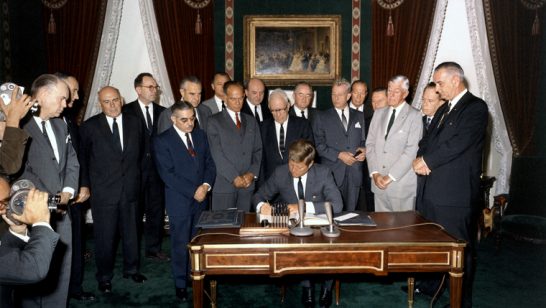
Not long ago, it seemed that nuclear arms control faced several difficult, but slowly developing problems—principally Iran, North Korea and the simmering issue of how to constrain tactical nuclear weapons. Now we have on our hands these earlier long-standing issues, all of which are getting worse, plus two new ones. These are the impending expiration of the New START Treaty and the dangerous situation created by the end of the INF Treaty. The latter stands out as the one without an obvious solution.
The path to the INF crisis developed in slow motion over several years and need not be recounted in detail here. The treaty entered into force in 1988 and solved a serious crisis, primarily in the European theatre. Skillful negotiations succeeded in eliminating all U.S. and Soviet ground-based ballistic and cruise missile systems with ranges between 500 and 5,500 km within only three years.
A major breakthrough in the treaty concerned verification, which involved an unprecedented level of intrusiveness. Five different types of on-site inspections were carried out by each side over 13 years—that is, for ten years after all the systems in question had been eliminated—about 850 inspections in all. Inspections were carried out at 31 NATO sites and 130 sites in the USSR, East Germany and Czechoslovakia. In addition, one site on each side was subject to Perimeter and Portal Continuous Monitoring (PPCM). Teams of monitors lived at these sites (Votkinsk in the southern Urals and a U.S. site in Magna, Utah) to assure that no prohibited missiles were being produced. Monitoring at both sites was complicated by the fact that production of permitted rockets was continuing at these factories. Agreeing on the details of all this OSI and PPCM was a major achievement of the INF Treaty and later agreements have drawn heavily on the INF experience.
The breaking of the Treaty
In July, 2014, after a long series of press reports, the Obama administration notified Congress that, since 2008, Russia had been flight testing a new cruise missile with a range over 500 km—a violation of the treaty. What followed was a slow-motion crisis that continued for 11 more years and, according to U.S. sources, involved 30 meetings at various levels trying to resolve the issue. The U.S., citing the need to protect intelligence sources and methods, did not provide any evidence for its allegations, at least publicly. Apparently little evidence was provided to the Russians or the NATO allies as well, at least for a long time. For its part, Russia denied even knowing what missile was being discussed, but in a counterattack, raised issues regarding U.S. compliance. The most serious of these was a claim that the Mk41 launcher being deployed in Poland and Romania as part of NATO’s ABM system could launch cruise missiles with range over 500 km. A “dialogue of the deaf” ensued, with no discernable progress. In 2017, the Trump administration reported that the missile in question, now designated the SSC-8 by NATO, had been deployed at two sites in Russia—a further violation. Russia finally acknowledged the existence of the missile, which it called the 9M729, but continued to deny all claims regarding its capability. In January, 2019, it released photos of the missile in its canister and gave a detailed briefing in Moscow of a particular flight, which it said traveled only 480 km. The U.S. did not address this flight or say whether it was part of the U.S. case for a violation.
On August 2, 2019, following formal notification of its intent to withdraw, given six months previously in accordance with treaty provisions, the U.S. did withdraw. All NATO countries officially sided with the U.S., but several expressed regret that the treaty could not be saved.
Was this failure inevitable?
Although the treaty was a complete success in achieving its stated goals, trouble had been brewing for a long time. For many years, Russia had been complaining that it made little sense for INF-range missiles to be forbidden to the Russia and the U.S., but unconstrained for third countries. Many countries in Russia’s neighborhood—in particular, China, North Korea, India, Pakistan, Iran and Israel—have INF-range missiles. Actually, the U.S., during the George W. Bush administration, did agree that “multilateralization” would be a good idea. However, no one could suggest a realistic plan to have these other countries take measures that would solve the problem. The U.S. did little to advance the idea of a multilateral INF and, if Russia made such efforts, they evidently also failed.
The Trump administration’s 2018 Nuclear Posture Review called attention to the growing capability of China, especially in its missile programs, and hinted at a need to respond in kind. Thus, the dirty little secret is that both sides were becoming uncomfortable with the bilateral restraints of the treaty, which could explain why efforts to save it seemed rather unimaginative. Appeals by such respected figures as George Shultz and Mikhail Gorbachev to save the treaty were to no avail. One possibility that was urged by several observers, including this author, was to allow an observation/inspection of both the 9M729 missile and the Mk 41 launcher. The Russian side did propose something like this very late in the negotiations, but it was rejected by the U.S. A good-faith reciprocal measure of this sort might still be useful.
Possible Solutions
It is clear that no one wants an unconstrained arms race in intermediate-range missiles. A major complicating factor is that the third countries noted above have developed such missiles because of regional concerns that have little or nothing to do with the U.S./NATO- Russia balance. It seems obvious China is the key third country and dealing with the others seems unrealistic for now (North Korea is the subject of separate negotiations). We have three types of constraints at our disposal:
- Numerical—there could be an agreed ceiling on the number of INF systems that could be deployed on each side
- Geographical—the deployment of INF systems could be limited to agreed geographical areas
- Technical—permitted INF systems could carry only conventional warheads
All three types of constraints were in play in the original INF negotiations, including in the famous “walk in the woods.” A solution now may well need to involve all three types. Geographic constraints would be especially useful—NATO Secretary-General Stoltenberg has already said the Alliance has no intention of deploying nuclear-armed missiles in Europe.
The U.S. flight tested an INF-range missile from a land-based launcher at its Vandenberg Test Range only two weeks after the treaty ended and is said to be considering four types of such missiles. That, plus the ongoing deployment of the 9M729, may mean that a return to a ban on such systems is already beyond reach. Nevertheless, a Putin letter to NATO proposed a “moratorium” on such deployments and said Russia would not be the first to deploy them. From the U.S./NATO point of view, this makes no sense in view of the existing 9M729 deployment. However, Russian analysts have claimed that “moratorium” was perhaps a poor choice of wording, was intended to lead to a negotiation and should not be interpreted to mean that Russia insists on such deployment. In any case, whether a return to zero is possible at a price the U.S./NATO would be willing to pay will not be known unless there is engagement on this idea.
When a problem appears intractable, a well-known technique for “getting to yes” involves enlarging the pie. In this case, the pie could kill several birds that have been plaguing us for a long time. Several possible aggregates come to mind:
- An aggregate of strategic and INF-range launchers—this would leave the sticky problem of tactical nuclear weapons until later
- An aggregate of strategic and all (not just land-based) INF-range launchers—including sea-based missiles of INF-range would be more comprehensive, but would probably meet strong objections from navies
- An aggregate of INF-range and short-range (tactical—less than 500 km) launchers—this would make sense if the New START Treaty remains in force
- An aggregate of strategic, INF-range and short-range launchers—this would be the most comprehensive option and would solve several problems if the New START Treaty is allowed to expire
Freedom to mix within these categories (perhaps with some sub-limits) would allow countries to tailor their forces to their individual security situations. The constraints could apply only to deployed systems, or to all such systems. Limits could apply to launchers, missiles, warheads or all three. There are some indications that the fourth aggregate might be the one of greatest interest to China, which has about 85% of its force in missiles below 5,500 km.
We should be aware that there could well be an arrangement for missiles on the Korean Peninsula separate from a broader settlement envisioned above. Finally, whether or not New START is still in force a year from now will clearly have an impact on what settlement of the INF problem makes the most sense.
The opinions articulated above represent the views of the author, and do not necessarily reflect the position of the European Leadership Network (ELN) or any of the ELN’s members. The ELN’s aim is to encourage debates that will help develop Europe’s capacity to address pressing foreign, defence, and security challenges.



